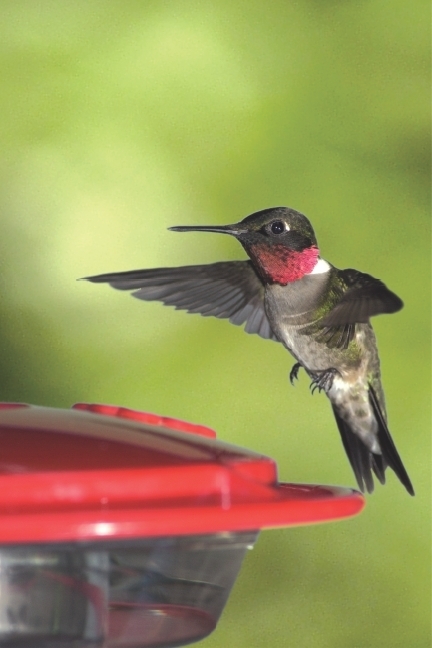Bird of the Month- Ruby-throated Hummingbird

Fun Facts About the Ruby-throated Hummingbird
- Hummingbirds weigh 1/10th of an ounce; about the weight of a penny.
- Hummingbirds hearts are larger proportionally to their body than any other bird or mammal.
- Hummingbirds have such underdeveloped legs that they are unable to walk well.
- A mother hummingbird weighs only about eight times more than her egg.
- Hummingbirds lay the world’s smallest bird egg.
- Hummingbirds generally lay two eggs, each about the size of a blueberry.
- Ruby-throated Hummingbirds have one of the highest nesting success rates of any neotropical migrant.
- Ruby-throated Hummingbirds will have two broods, each taking 45 days from nest construction to fledging.
- Hummingbirds use spider webs as glue to attach the nest to a tree branch as well as a binding agent for the building materials.
- The nest is about the size of a golf ball; around 1 inches in diameter.
- Only about 20% of Ruby-throated Hummingbird fledglings survive their first year.
- Hummingbirds eat about every ten minutes.
- Hummingbirds learn to associate flower colors, like red, with food. They do not have an innate preference for red.
- Hummingbirds can drink up to twice their body weight in nectar every day
- Hummingbirds lap up nectar with their long tongues. There is a groove on either side of the tongue that creates a capillary action to help draw the nectar up the tongue and into the mouth during the lapping action.
- Hummingbirds can extend their tongue approximately a distance equal to the length of their bill.
- While lapping up nectar, Hummingbirds can move their tongues in and out of their bill at a rate of up to 12 times a second.
- Female Hummingbirds tongues are longer than the males.
- They eat insects and insect eggs on the ground and in trees. They love spiders and spider eggs. They use their bill and not their tongue to catch insects.
- Hummingbirds can fly up to 60 miles per hour, but typically fly at 30-45 miles per hour.
- They can hover and are the only birds able to fly backwards and upside down. They can do this because of an extremely mobile shoulder joint.
- Their wings beat 20-80 times per second.
- During the night, Ruby-throated Hummingbirds can enter into a state of torpor to save energy. Similar to a type of short-term hibernation, torpor reduces their metabolic activity and drops their heart rate from 1,200 beats per minute to 50 beats per minute.

